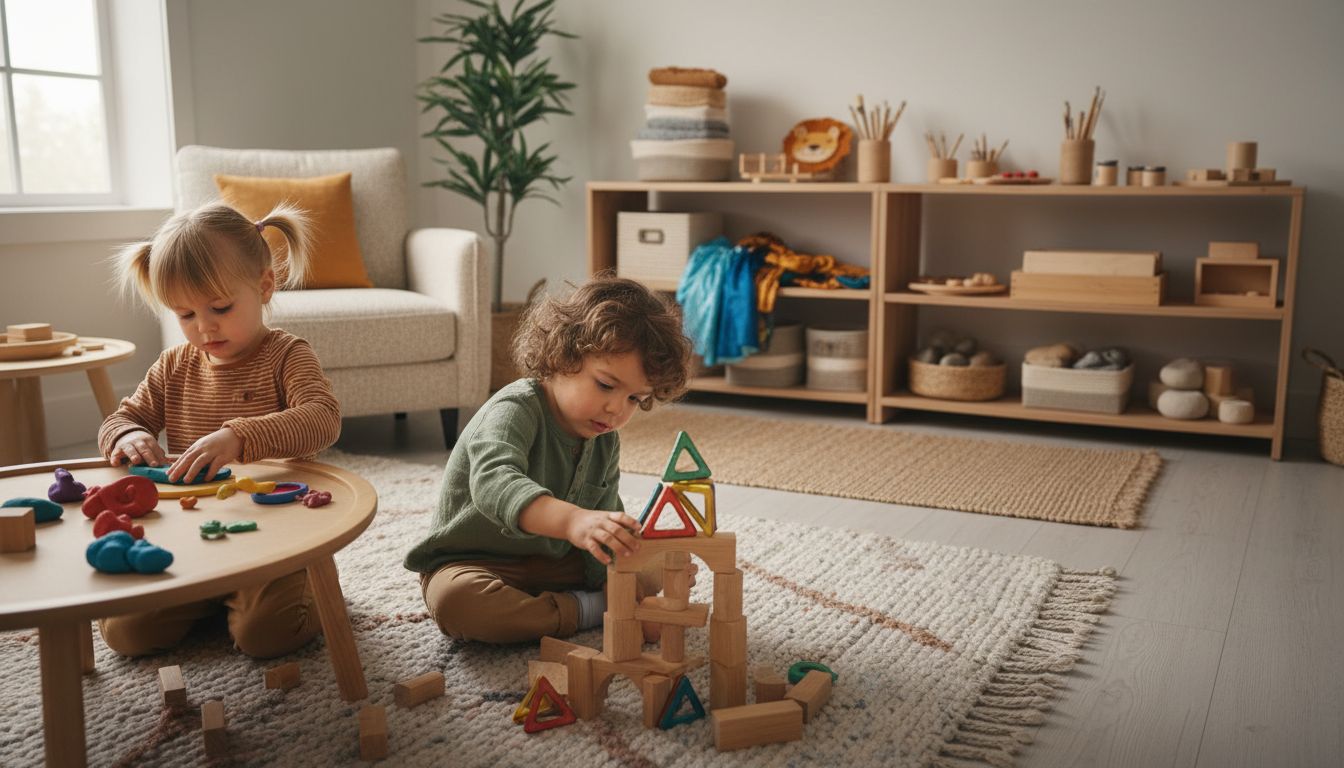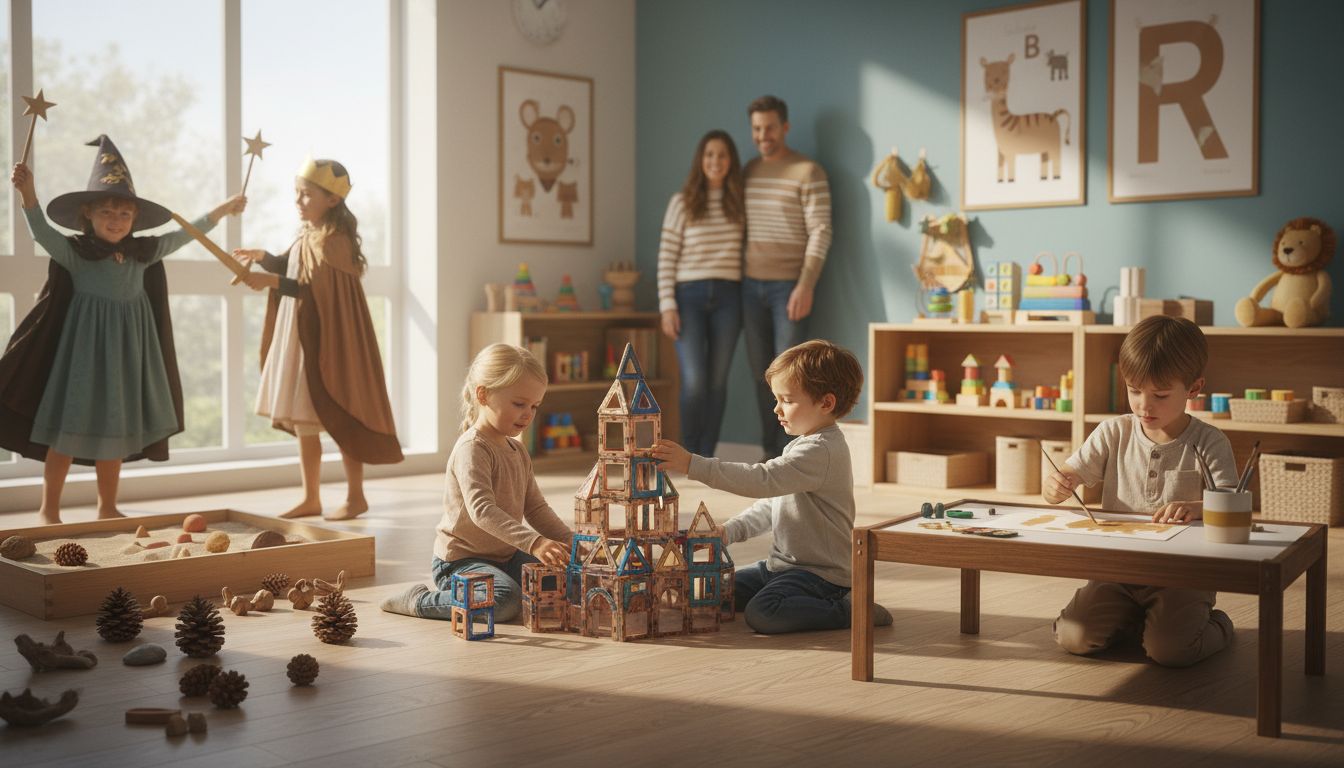Did you know that children who engage in open-ended play score up to 25 percent higher on measures of creativity and problem-solving? Imagination and creativity in play do more than fill the hours with fun. These skills shape the way children think, learn, and express themselves every day. By understanding how playful moments nurture imagination, parents and caregivers can help kids unlock endless possibilities for growth and discovery.
Table of Contents
- Defining Creativity And Imagination In Play
- Categories Of Toys That Spark Creativity
- Key Features Of Creative And Sensory Toys
- Benefits Of Creative Play For Child Development
- Avoiding Common Pitfalls With Creative Toys
Key Takeaways
| Point | Details |
|---|---|
| Importance of Play | Play is essential for children’s creativity and imagination development, serving as a laboratory for exploring ideas and solving problems. |
| Role of Open-Ended Toys | Using open-ended toys encourages children to engage in imaginative play, fostering cognitive flexibility and problem-solving skills. |
| Supporting Creativity | Parents should create environments that allow for unstructured play and minimize over-direction, fostering natural imaginative exploration. |
| Avoiding Common Mistakes | To maximize creative potential, avoid comparing children’s outputs and provide a safe space for experimentation without premature criticism. |
Defining Creativity And Imagination In Play
Play is the magical realm where children transform ordinary moments into extraordinary adventures. Creativity and imagination are fundamental developmental skills that emerge naturally through playful interactions, allowing children to explore possibilities beyond their immediate reality.
According to research from the British Council, creativity involves generating innovative ideas that capture interest and are often developed through play activities. Pretend play specifically enables children to project mental representations onto reality, examining scenarios from multiple perspectives and solving problems creatively. This means when a child uses a cardboard box as a spaceship or transforms a blanket into a superhero cape, they are actively developing critical cognitive skills.
Importantly, imagination and creativity are not identical concepts. As academic research indicates, while both involve thinking removed from immediate reality, creativity requires discretion and intentional problem-solving - skills that typically develop during preadolescence and adolescence. For young children, play becomes the primary laboratory where these skills are experimentally tested and refined.
Parents can nurture creativity by providing open-ended toys that inspire imaginative play, encouraging unstructured playtime, and allowing children to lead their own imaginative experiences without excessive adult direction. The goal is creating an environment where imagination can flourish naturally.
Categories Of Toys That Spark Creativity
Not all toys are created equal when it comes to nurturing a child’s creativity. Open-ended toys stand out as powerful catalysts for imaginative play, encouraging children to transform simple objects into extraordinary experiences.
According to research from the British Council, creative play involves activities like building with toy bricks, drawing, inventing, or dancing - all of which provide opportunities to develop essential transferable skills. Our comprehensive guide to open-ended toys reveals several key categories that naturally stimulate creativity:
- Construction Toys: Building blocks, magnetic tiles, and engineering sets that allow children to design and construct unique structures
- Dramatic Play Sets: Costumes, play kitchens, and role-playing accessories that enable children to explore different perspectives and scenarios
- Art and Craft Materials: Drawing supplies, modelling clay, craft kits that encourage free-form expression and artistic exploration
- Sensory Play Tools: Sand, water tables, textured materials that invite open-ended tactile investigation
Creative play helps children develop critical problem-solving skills by allowing them to express themselves freely. When children build dens, experiment with toys, or invent imaginary worlds, they’re not just playing - they’re developing cognitive flexibility, learning to think beyond conventional boundaries, and building confidence in their creative capabilities.

Here’s a summary of toy categories and how they spark creativity:
| Toy Category | Key Characteristics | Examples |
|---|---|---|
| Construction Toys | Build and design Open-ended combinations |
Building blocks Magnetic tiles Engineering sets |
| Dramatic Play Sets | Role-playing Scenario exploration |
Costumes Play kitchens Role-play accessories |
| Art and Craft Materials | Artistic expression Free-form creation |
Drawing supplies Modelling clay Craft kits |
| Sensory Play Tools | Tactile stimulation Multi-sensory engagement |
Sand Water tables Textured materials |
Key Features Of Creative And Sensory Toys
Creative and sensory toys are more than just playthings - they are powerful developmental tools that transform ordinary play into extraordinary learning experiences. These special toys go beyond simple entertainment, offering children unique opportunities to explore, experiment, and express themselves.
According to research from the British Council, creative play involving activities like building, drawing, and inventing provides essential opportunities to develop transferable skills. Our guide to understanding creative toys as gifts highlights several critical features that distinguish these remarkable play companions:
- Open-Ended Design: Toys without predetermined outcomes that encourage multiple ways of interaction
- Multi-Sensory Engagement: Materials that stimulate touch, sight, sound, and sometimes even smell
- Complexity and Adaptability: Toys that can be used differently as children grow and develop
- Minimal Pre-Scripted Instructions: Allowing children to drive their own play narrative
Research indicates that creative play helps children develop critical problem-solving skills by allowing free expression. When children interact with these thoughtfully designed toys, they’re not just playing - they’re building cognitive flexibility, learning to think innovatively, and developing confidence in their ability to create and explore. The magic lies in giving children tools that respond to their imagination, rather than dictating how they should play.
Benefits Of Creative Play For Child Development
Creative play is a powerful developmental catalyst that transforms simple playtime into a rich learning experience. Far more than just entertainment, it serves as a critical pathway for children to explore, understand, and interact with the world around them.
According to research from the British Council, pretend play enables children to examine scenarios from multiple perspectives and develop innovative problem-solving strategies. Our guide to toys that boost learning highlights several key developmental benefits:
- Cognitive Flexibility: Helps children adapt thinking and approach challenges creatively
- Perspective-Taking: Develops empathy and understanding of different viewpoints
- Emotional Intelligence: Allows exploration of feelings and social interactions
- Problem-Solving Skills: Encourages experimental thinking and resilient approaches to challenges
Research indicates that creative play processes mirror collaborative adult creative groups, promoting a sense of autonomy and developing critical cognitive skills. When children engage in imaginative play, they’re not just having fun - they’re building foundational skills that will support their learning, social interactions, and emotional growth throughout their lives. The magic happens when play becomes a child’s natural laboratory for understanding complexity, negotiating relationships, and expressing their unique inner world.
Avoiding Common Pitfalls With Creative Toys
Creative toys are powerful learning tools, but parents can inadvertently limit their potential by making common mistakes. Understanding these potential pitfalls is crucial to maximising the developmental benefits of imaginative play.
Research suggests that while creative play has significant potential, simply providing toys does not automatically guarantee creative development. Our guide to gifting educational toys highlights several key strategies to avoid undermining children’s creative potential:
- Over-Directing Play: Resist the urge to constantly guide or prescribe how toys should be used
- Limiting Exploration: Allow children to interact with toys in unexpected and unconventional ways
- Premature Criticism: Avoid judging or evaluating creative attempts too quickly
- Comparison Traps: Never compare a child’s creative output with others
According to the British Council, pretend play provides opportunities for children to set joint goals and examine scenarios from multiple perspectives. The key is creating an environment of psychological safety where children feel free to experiment, make mistakes, and explore without fear of judgment. By understanding that creativity is a process rather than a fixed outcome, parents can support their children’s imaginative development more effectively.
Unlock Your Child’s Creative Potential with the Perfect Toys
The article highlights a common challenge parents face today: finding toys that truly inspire imagination and foster developmental growth without over-directing play. If you want to support your child’s cognitive flexibility and emotional intelligence through open-ended, sensory-rich experiences, you need toys that encourage exploration and problem-solving rather than restrict it. Learning Bugs specialises in carefully curated collections that respond to exactly this need.

Explore our range of creative and sensory toys designed to nurture your child’s unique creative journey. Our selection includes wooden toys, role play sets, and educational kits that grow with your child and invite endless imaginative possibilities. Visit Learning Bugs today and discover timeless toys that transform every play session into a meaningful experience. Don’t wait to empower your child’s creativity and watch their confidence flourish with every adventure.
Frequently Asked Questions
How do toys inspire creativity in children?
Creative toys stimulate imaginative play, allowing children to explore, experiment, and express themselves. By engaging with open-ended toys, children can transform simple objects into unique experiences, which fosters critical cognitive skills such as problem-solving and adaptability.
What are open-ended toys, and why are they beneficial?
Open-ended toys are playthings designed without predetermined outcomes, encouraging children to interact in multiple ways. They benefit creativity by giving children the freedom to invent their own narratives and solutions, thereby enhancing cognitive flexibility and innovative thinking.
How can parents avoid limiting their child’s creativity with toys?
Parents can avoid limiting creativity by resisting the urge to over-direct play, allowing children to explore toys in unconventional ways, and fostering an environment of psychological safety. This encourages experimentation and helps children feel free to express their ideas without fear of criticism.
What types of toys are best for encouraging imaginative play?
The best types of toys for encouraging imaginative play include construction toys, dramatic play sets, art and craft materials, and sensory play tools. These toys support various forms of creative expression and problem-solving skills by allowing children to engage in free-form play.

0 comments